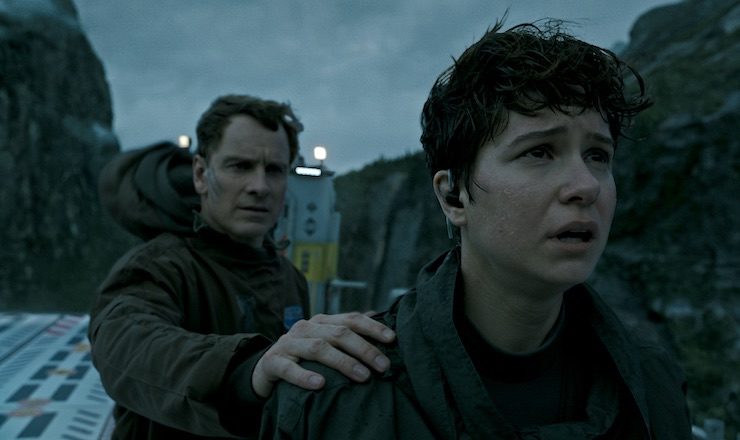The Covenant is en route to set up what’s implied to be one of the first interstellar colonies. With 2000 colonists in cryo sleep and a crew of 15, the ship is state of the art, packed with everything the colony will need, and ready to make history. That is until first an accident, and then an impossibility lead them to the discovery of a new target world. Closer, far better suited to their needs than the original destination, and home to an apparently human generated signal where no human has ever been before. Rattled, desperate for some good news and curious, the crew of the Covenant takes a look. And that’s when the trouble really starts…
Sir Ridley Scott makes a second return to the Alien franchise with Covenant and the good news is it’s much more successful than his first trip back in Prometheus. The bad news is that this is arguably the least accessible of the Alien movies to date. Where the previous movies are refreshingly simple in concept (they basically boil down to: “Truckers vs. angry ant!”, “Marines vs. lots of angry ants!”, “The highest budget episode of Oz EVER!”, “Firefly Episode Zero vs Angry Ants!’, and, finally, “Idiots vs. Erich Von Däniken’s fever dreams!”) this is an Alien prequel in name and a Prometheus sequel in intent. Everything we see, from that mysterious signal to the creature itself, is closely tied to Scott’s most recent entry in the franchise.
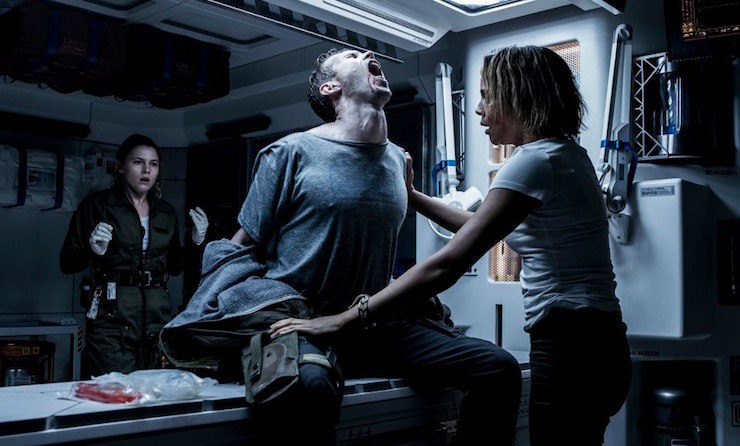
Let’s do the good news first. The closest one of those connections is between the Synthetics and the Xenomorphs. Covenant is at its best when exploring the fundamental conflict between Creator and Created: the Engineers and the black goo; Peter Weyland and his Synthetic children; humanity and artificial humanity. The movie has a lot of big, chewy interesting things to say about these conflicts and says them all very well. Better still, shot through with the space trucker practicality of Alien in particular, these deeply weird and SFnal concepts land with surprising force. Even more good news, it looks like those concepts are going to be very much front and centre in Alien: Covenant II: Covenanter which is apparently less than two years away. (Word on Alien: Covenant With A Vengeance remains uncertain at this time.)
There’s more good news: at least two major questions about the Alien franchise as a whole are definitively answered here. In my recent overview piece, I talked about how each movie in the franchise has explored the Xenomorph in a subtly different way and Covenant is meant to be the umbrella under which all those approaches are finally gathered. There’s a clear attempt here to tie together five previous writing team’s attempts at playing in the same universe and, I’m delighted to report, it’s pretty successful. By the end of Covenant you’ll see the Xenomorph very differently. Better still, by the end of Covenant you’ll almost certainly view one or more of the more controversial entries in the series in a kinder light.
It’s a shame, then, that Covenant itself isn’t very good. As a carrier medium for this injection of narrative franchise DNA, it’s great. As a standalone movie, though, it’s far, far weaker.
Light spoilers ahead.
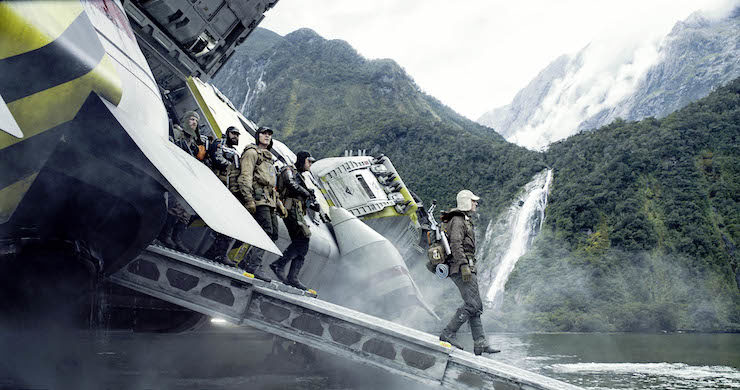
A massive part of that is down to a couple of fundamental flaws in the premise. While never stated outright, it’s implied that the Covenant is at the very least one of the first interstellar colony vessels, if not the first. Much is made of this being a long trip, a big deal, and a huge sacrifice. It’s an expedition of incalculable worth, both historical and financial…
And it has one shuttle.
The only reason that happens to the case, as near as I can tell, is so that the second act can take place. Take the capacity for a second shuttle to evacuate the ground team away and you’ve got a good movie. Leave basic engineering redundancy in there instead and you’ve got a gaping plot hole, through which Michael Fassbender (doing his Peter O’Toole impersonation) happily skips. To be absolutely clear: everything that happens in the later two-thirds of this film is predicated on one of the most expensive, important expeditions in human history assuming they’ll only ever need one shuttle. It’s that ridiculous. There are other problems, too—not the least of which is the brief and unwelcome return of the “What Happens If I Prod This Thing?” school of xenobiology.
That trouble is compounded by Scott’s weirdly inconsistent action sequences. The first alien reveal is a nicely handled, escalating piece of body horror. The fight that follows it is laughably incoherent. It’s not alone, either, as a later fight between two crew members is essentially impossible to follow and the closing action sequence feels weirdly truncated. Only an extended fight/chase/escape involving a cargo lifter impresses, and it’s notable that it’s the only action sequence that takes place in daylight.
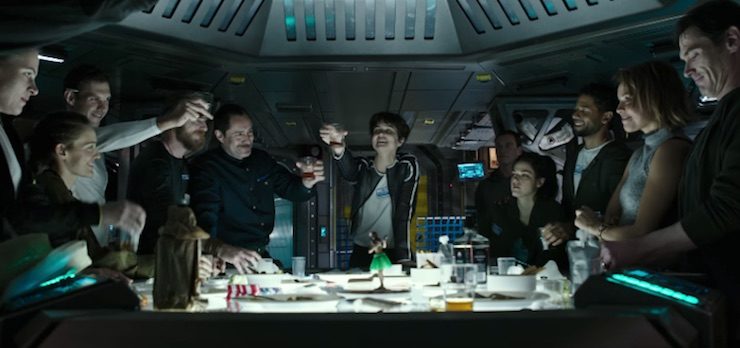
Even worse, especially for a franchise like this, is how little you get to know the characters. Aside from the core quartet of Daniels, Tennessee, Oram, and Walter, the rest of the Covenant’s crew may as well be balloons with faces drawn on them. That pulls the teeth out of every action sequence and, worse still, lowers the overall stakes. In doing so, it also renders the fact that the crew is composed of couples in romantic partnerships completely moot. If you don’t know who just died, you don’t feel like you have to care about them. The worst example of this is the crew’s single gay couple—who are only canonically confirmed as such once the body count starts to rise. Which isn’t so much having your cake and eating it, too, as setting fire to your cake and only then pointing out that there was cake and insisting you deserve points for bringing it.
Maddeningly, the few times the script actually bothers to engage with the relationships that are supposedly at the core of the movie’s premise is when it’s strongest. The Orams are a fascinating couple we spend nowhere near enough time with. A major friendship elsewhere is based on mutual sympathy and grief and for the (literally) 120 seconds the movie focuses on that bond, it’s amazing. There’s a great character-driven SF movie, here—it just gets lost under all the incoherent jump cuts and screaming.
But the film’s most egregious crime is how regularly it not only mistakes cruelty for horror, but how tone deaf it is in doing so. Without getting completely spoilery, there’s a major plot point that’s going to be a kick in the teeth for a lot of fans and it’s one that the movie really, really belabours. The lowest point comes at the end of one of the bizarrely badly shot action sequences. It’s a cutaway shot, one that you’ll know when you see it. From that point on, the film is on an express elevator, not to Hell, but straight into completely predictable storytelling—and it never deviates once. This shift renders the series down to the exact sort of cookie-cutter storytelling that horror cinema is so often accused of perpetuating. The Alien franchise is one of the standard bearers for great cinematic horror, and to see the newest installment so formulaic is sadder than it is disturbing.
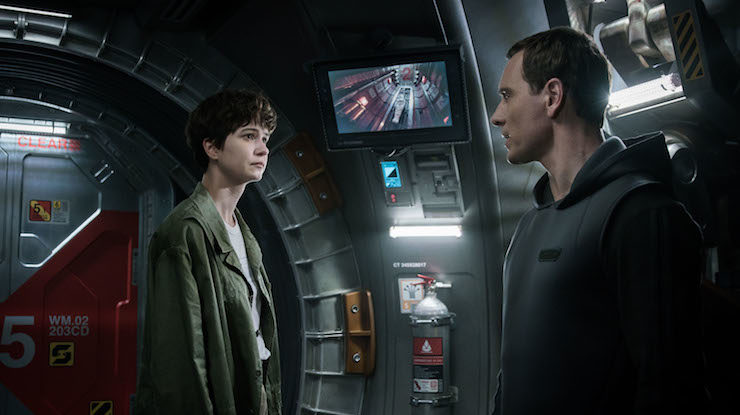
And then there’s the return of the sexual assault subtext. Or in some cases here, “text.” The Xenomorph lifecycle has always had that element to it, but there are moments here where character-based cruelty steps all the way over the line from entertaining horror to flat-out, stomach-pitting nausea. David, the Synthetic first played by Fassbender in Prometheus, is clearly being set up here as the series’ defining villain. Given that he’s positioned there via the persistent mutilation and commoditization of female characters, the film clearly dives for the lowest common denominator and stays there, steeped in cheap cruelty that plays as just this side of malicious. Crucially, it’s intensely conservative in its portrayal of women, too—whether it’s intended or not, every female character is traumatized, brutalized, or reductively treated as nothing more than a womb in Alien: Covenant. That makes their portrayal far more dated than the supposedly “retro” tech of the Covenant and means that the film comes across as mean-spirited when it should be disturbing, and cruel when it should be subtle.
So, the question you’re probably asking right now is whether it’s worth bothering with? And the answer is, yes.
Barely.
The metanarrative here is fascinating. So much so that I actually really want to discuss it in more detail, if nothing else because it does exactly what I talked about in the overview piece and changes the franchise in a variety of really interesting ways. Likewise, the central cast are all very good. Katherine Waterston and Danny McBride especially are flat-out brilliant and both bring a very different energy to the series that helps it enormously. The design work is great, the locations are gorgeous, and the action that does work actually works very well, indeed. But for all that, this feels like a bridge between franchises in the very worst way. It has almost all of Prometheus’ flaws as well as far too many of the Alien franchise’s, and doesn’t play enough to the strengths of either. It’s a definite improvement on Prometheus but, thanks to the stupidity and cruelty that so often drives the plot, it’s clear that both the franchise and the crew of the Covenant still have a very long way to go.
Alasdair Stuart is a freelancer writer, RPG writer and podcaster. He owns Escape Artists, who publish the short fiction podcasts Escape Pod, Pseudopod, Podcastle, Cast of Wonders, and the magazine Mothership Zeta. He blogs enthusiastically about pop culture, cooking and exercise at Alasdairstuart.com, and tweets @AlasdairStuart.










